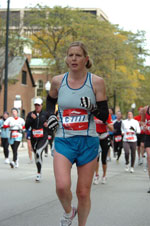The Semenya debacle continues…yesterday, the IAAF issued a release noting that a) the discussion of the Semenya issue had been tabled, and that b) testing of Semenya had not been completed…
Below is a thoughtful blog from Jill M. Geer, USATF Chief Communications Officer, and defacto, the voice of USA Track & Field, who has written a blog on the Myth of Fairness and the question of Gender. Jill has done a nice job of putting this sad stain on our sport in perspective.
At the end of her piece, I have placed several links from RBR coverage of the Semenya story. After re reading them, I still believe the following: a) the IAAF needed and still needs a thoughtful and discreet gender policy, b) ASA knew about the issue and should never have brought Caster Semenya to Berlin, and c) in the end, the life of an eighteen year old athlete has been irrevocably damaged…there is blame enough to go around everywhere…
The myth of fairness meets the question of gender
by Jill M. Geer, USATF Chief Communications Officer
Thursday, November 19, 2009

Jill Geer running 2009 Bank of America Chicago Marathon,
October 11, 2009, photo by PhotoRun.net.
Editor’s Note: Readers are advised that the following blog deals with issues of gender determination and sexual characteristics.
Link to original article: https://www.usatf.org/about/leadership/OffTheRecordBlog/
On Wednesday, the IAAF announced that Caster Semenya is “still undergoing gender tests,” which means that one of the most talked-about stories in all of sport, since it first made headlines at the World Championships in Berlin, is still without an ending, happy or otherwise. That it is taking months to come up with a solution is a vivid illustration of the complexity of a controversy that, in the end, will have no winners.
When I returned from Berlin, people who I am quite certain know little to nothing about track, from relatives to day-care workers to secretaries and real-estate agents, welcomed me back. Almost all conversations went something like this:
Friend: “Welcome back, Jill, how was Berlin?”
Jill: “It was great, thanks. Our team did really well, the city is terrific and I saw some art that looked like neon avian porn.”
Friend: “Great. But I’ve got to ask you . . . ”
Jill (interrupting friend, anticipating the “What’s up with Semenya?” question): “I have no idea.”
How the story was leaked and how it has played out has done nothing but tarnish the reputations of everyone involved. Regardless of what went on behind the scenes, who knew what and when, who did what examination or who leaked what to whom, this has played out like a Greek tragedy of Sophoclean proportions. The victims include, in no particular order, Semenya, her competitors and anyone in society who is, to use a term often employed in gender studies, “other.”
When the story first broke, what most concerned me was the idea that somebody’s sex could be called into question simply because of how she looked or how low her voice was. As I’ve noted to many people, I was one of those girls who was always with the guys, wearing my brother’s hand-me-downs, playing sports with (and beating 98 percent of) the guys, and being mistaken for a boy until I was in at least 7th grade. Put me on a weight-lifting regimen and I’ll be ready to star in Terminator 4. I sing tenor, and a four-year-old once called me “he” . . . when I was about 23 years old.
So when people start to snicker or sneer at an athletic woman because she doesn’t look like a Barbie doll, I get pissed off.
However, if the calls for sex-testing Semenya were due to something beyond just how she looks or sounds, to include knowledge of events or discussions that went on prior to Berlin, that’s another circumstance entirely. I don’t know which was the case with Semenya.
Regardless, she is almost universally, and rightly, considered to be an innocent in this who has been wronged by those around her, most of whom, it must be noted, seem to have external male genitalia. But an obvious mistake that Semenya did make came in Berlin. After winning the 800 in impressive fashion, she crossed the finish line and flexed her muscles. Maybe it was an act of defiance and of wanting to explode gender codes. But if it was her hope that people would focus on her running and not the headlines, it was a colossal error in judgment.
Also working against her was the fact that she is coached by a man who, according to the Times of London, “was named as a key figure in the East German doping machine in a German parliamentary inquiry (who) has admitted his involvement in the drug programme…” Indeed, the East German connection and her subsequent, incredible improvement in performance is why the IAAF first raised eyebrows about her performances in 2009, not because of how she looked.
Reading about her case has been an eye-opening education for me as I’ve learned about the incredible varieties of genetics that cause huge variations in what is male and female. It’s like learning that it’s not always day and night; it’s often dusk and dawn. Until you read about and understand the science, it is hard to understand why the case isn’t clear-cut.
Of course, the uncertainty only makes the issue more tragic. If I were an athlete who finished behind Semenya, I would feel bitterly angry and cheated. If I were Caster Semenya, I’d feel equally cheated, and perhaps even more so: I’d feel I’d been cheated not out of a medal but out of my right to enjoy my life. Not only has her performance been called into question, but her entire life has been made the subject of intense public debate, cruel jokes and salacious rumor-mongering. In a classic bit of side-show grotesquery, she was even trotted out in sequins for a South African women’s magazine.
These are just a few reasons to feel angered by the whole affair, but if Semenya was put in a position to compete when people close to her knew there might be an issue regarding her sex, it is even more infuriating.
There are so many questions, but few, if any answers. In a sport divided into male and female competition, how do you define sex? Is it chromosomal, hormonal, physical, psychological, or something else entirely? Who should be gender-tested and when? Who should and should not be allowed to compete?
The fundamental job of the IAAF and all governing bodies is to ensure that competition is fair. To that end, they establish rules about competition, ban blatantly unfair practices such as doping and generally try to keep the undertaking civilized. Part of creating a fair sport has always been the concept of having women compete and against women and men against men.
Erin Buzuvis of the Western New England School of Law in October delivered a paper entitled “Caster Semenya, Sex, and the Myth of a Level Playing Field.” While I don’t necessarily agree with many of her assertions, that she attempts to lay out a rational argument as much as possible is to be lauded.
Most interesting to me is that she wrote about what she called “The Myth of the Level Playing Field”. Even if competition is divided along the lines of sex, she argues, there is inherent natural variation and “unfairness” within the sexes. What is fair, and is it possible and desirable to try to create fairness when there is no such thing as a truly level playing field in sport? To wit, some women have naturally higher testosterone, and more strength, than others. Some runners have grown up at altitude and therefore have an advantage in distance running. Some athletes are wealthy and can afford training aids that others can’t.
I don’t believe that the issue can and will ever be resolved in black and white, or in X and Y. I envy none of the scientists or IAAF officials who were forced in a very public way to make a determination on something that is at its very root amorphous and almost indefinable. But somebody’s got to do it.
What is clear is that the entire saga has been unfair to almost everyone involved. My empathy goes to the women who were beaten by Caster Semenya, to Semenya and her family and friends, to the South African people, and to anybody who has ever been made a joke for not conforming to traditional ideas of what people should look or sound like.
All’s fair in love and war, but nothing, it seems, is entirely fair in sport, especially when it becomes a battle of the sexes.
For more on USA Track & Field, please check out http://www.usatf.org
List of recent columns on Caster Semenya, ASA, Gender topics:
Caster Semenya was Tested by ASA, August 2009
https://www.runblogrun.com/2009/08/caster_semenya_tested_by_asa_b.html
Caster Semenya Saga Moves On, September 2009
https://www.runblogrun.com/2009/09/caster_semenya_saga_moves_on_w.html
The Sad & Curious Case of Caster Semenya, August 2009, updated September 16, 2009
https://www.runblogrun.com/2009/09/the_curious_and_sad_story_of_c.html
RBR Ombudsman: Semenya Updated & Corrected, September 16, 2009
https://www.runblogrun.com/2009/09/rbr_ombudsman_update_on_caster.html
ASA Knew about Semenya Debacle, September 2009
https://www.runblogrun.com/2009/09/asa_knew_about_semenya_debacle.html
For twenty-four different views of our sport, please click on http://www.runningnetwork.com
RelatedPosts
Author

Larry Eder has had a 52-year involvement in the sport of athletics. Larry has experienced the sport as an athlete, coach, magazine publisher, and now, journalist and blogger. His first article, on Don Bowden, America's first sub-4 minute miler, was published in RW in 1983. Larry has published several magazines on athletics, from American Athletics to the U.S. version of Spikes magazine. He currently manages the content and marketing development of the RunningNetwork, The Shoe Addicts, and RunBlogRun. Of RunBlogRun, his daily pilgrimage with the sport, Larry says: "I have to admit, I love traveling to far away meets, writing about the sport I love, and the athletes I respect, for my readers at runblogrun.com, the most of anything I have ever done, except, maybe running itself." Also does some updates for BBC Sports at key events, which he truly enjoys. Theme song: Greg Allman, " I'm no Angel."
View all posts




















